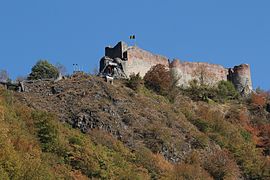Poenari Castle
| Poenari Citadel | |
|---|---|
Cetatea Poenari | |
 | |
 | |
| Alternative names | Citadel of Țepeș Vodă Citadel of Negru Vodă |
| General information | |
| Location | |
| Construction started | 1453[1] |
| Dimensions | |
| Diameter | 60 m |
| Design and construction | |
| Architect(s) | Negru Vodă |
45°21′13.49″N 24°38′6.80″E / 45.3537472°N 24.6352222°E
Poenari Castle (Romanian pronunciation: [po.eˈnarʲ]), also known as Poenari Citadel (Cetatea Poenari in Romanian), is a ruined castle in Romania, notable for its connection to Vlad the Impaler. Access to the citadel is made by climbing the 1,480 concrete stairs.
Location
The castle is located on the plateau of Mount Cetatea, facing the west side of the Transfăgărășan, on a canyon formed on the Argeș River valley, close to the Făgăraș Mountains.
History
Poenari Castle was constructed around the beginning of the 13th century by Wallachians.[dubious – discuss][citation needed] Around the 14th century, Poenari was the main citadel of the Basarab rulers.[2][3] In the next few decades, the name and the residents changed a few times but eventually the castle was abandoned and left in ruins.


However, in the 15th century, realizing the potential for a castle perched high on a steep precipice of rock, Vlad III the Impaler repaired and consolidated the structure, making it one of his main fortresses. Although the castle was used for many years after Vlad's death in 1476, it eventually was abandoned again in the first half of the 16th century and was in ruins by the 17th century. The size and location of the castle made it difficult to conquer. In 1888, a landslide caused by an earthquake brought down parts of the castle which crashed into the river far below. It was slightly repaired and the walls and its towers still stand today.
During the Communist era in Romania, foreign visitors sometimes spent the night inside the ruined structure.[4][5] Since 2009, the site has been administered by the Argeș County Museum.[6]
Claims that the Poenari Castle would be the "real" Castle Dracula as featured in Bram Stoker's famous Dracula novel have no basis in Stoker's book. There is no proof that Stoker knew of Poenari Castle and the castle is situated roughly 200 km to the south of the novel's place of action, which was in the north-east corner of Transylvania.
In popular culture
A modern rendering of Poenari Castle was featured in the 2013 STARZ television series Da Vinci's Demons in the episode titled "The Devil" in which Leonardo da Vinci travels to Poenari Castle in Wallachia to meet with Vlad III.
The episode "The Hardy Boys & Nancy Drew Meet Dracula" of The Hardy Boys/Nancy Drew Mysteries show in the '70s takes place inside "Dracula's Castle" in "Poenari". Shots of the castle used in the episode are Poenari Castle, though the episode shows folks driving up to the castle gates for a rock festival—impossible to do, as you must climb stairs to get anywhere near the ruins.
Gallery
-
View from the citadel towards Transfăgărăşan
See also
References
- ^ "Cetatea Poenari". Welcome to Romania (in Romanian).
- ^ "Poenari Fortress: The Eagles' Nest of Vlad the Impaler". Uncover Romania. Retrieved 11 April 2018.
- ^ Guiley, Rosemary. The Encyclopedia of Vampires, Werewolves, and Other Monsters.
- ^ Hadden, Robert Lee. 1975. "A Night Spent in Prince Dracula's Ancient Castle." Daily Reflector (Greenville, NC newspaper). February 23, 1975, page B5.
- ^ Cooper, Aaron (Oct 30, 2010). "Staking out Dracula's castle in Romania". CNN. Retrieved 10 May 2016.
- ^ Enciclopedia Argeșului și Muscelului - M, at the University of Pitești Enciclopedia Argeșului și Muscelului site, p. 123 Template:Ro icon
External links
- Photos from the castle and visitors' information
- Some pictures from the Castle
- Speculative drawings of what the castle could have looked like by illustrator Salgood Sam.







